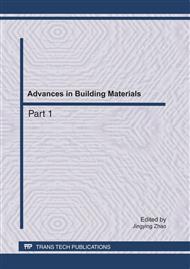p.581
p.586
p.591
p.596
p.601
p.606
p.613
p.618
p.623
Microstructural Investigation of Carbonation of Calcium Silicate Hydrate in Hydrated Cement Paste
Abstract:
Carbonation is one of the most common degradation reactions of concrete which greatly shortens the service life of steel-reinforced concrete structure. The carbonation of synthetic calcium silicate hydration derived from hydrated cement paste is investigated with microstructural characterization method including scanning electron microscopy, X-ray diffraction analysis, coupled TG-DSC analysis and Fourier transform infrared spectroscopy. The changes in the morphology, mineral composition and polymerization degree of the calcium silicate gel before and after the carbonation are investigated. The major finding of the research includes that the C-S-H collapses during the carbonation reaction, which actually densifies the microstructure. The major hydration product is calcite. The carbonation resistance of C-S-H is enhanced with increasing C/S ratio. The polymerization degree of C-S-H is increased by the carbonation reaction.
Info:
Periodical:
Pages:
601-605
Citation:
Online since:
May 2011
Authors:
Keywords:
Price:
Сopyright:
© 2011 Trans Tech Publications Ltd. All Rights Reserved
Share:
Citation:


